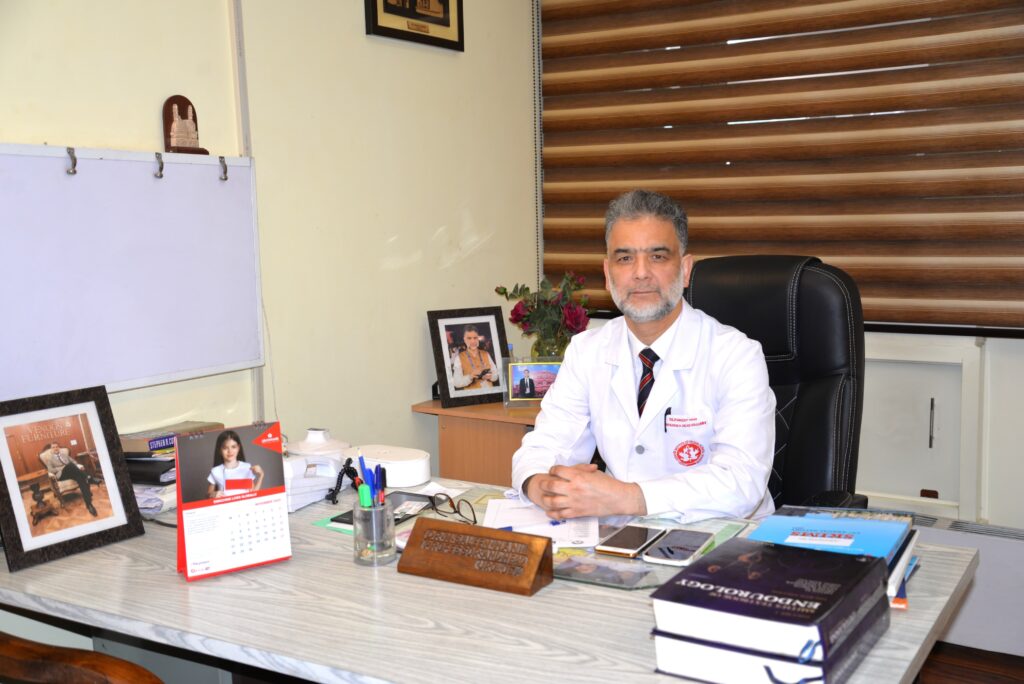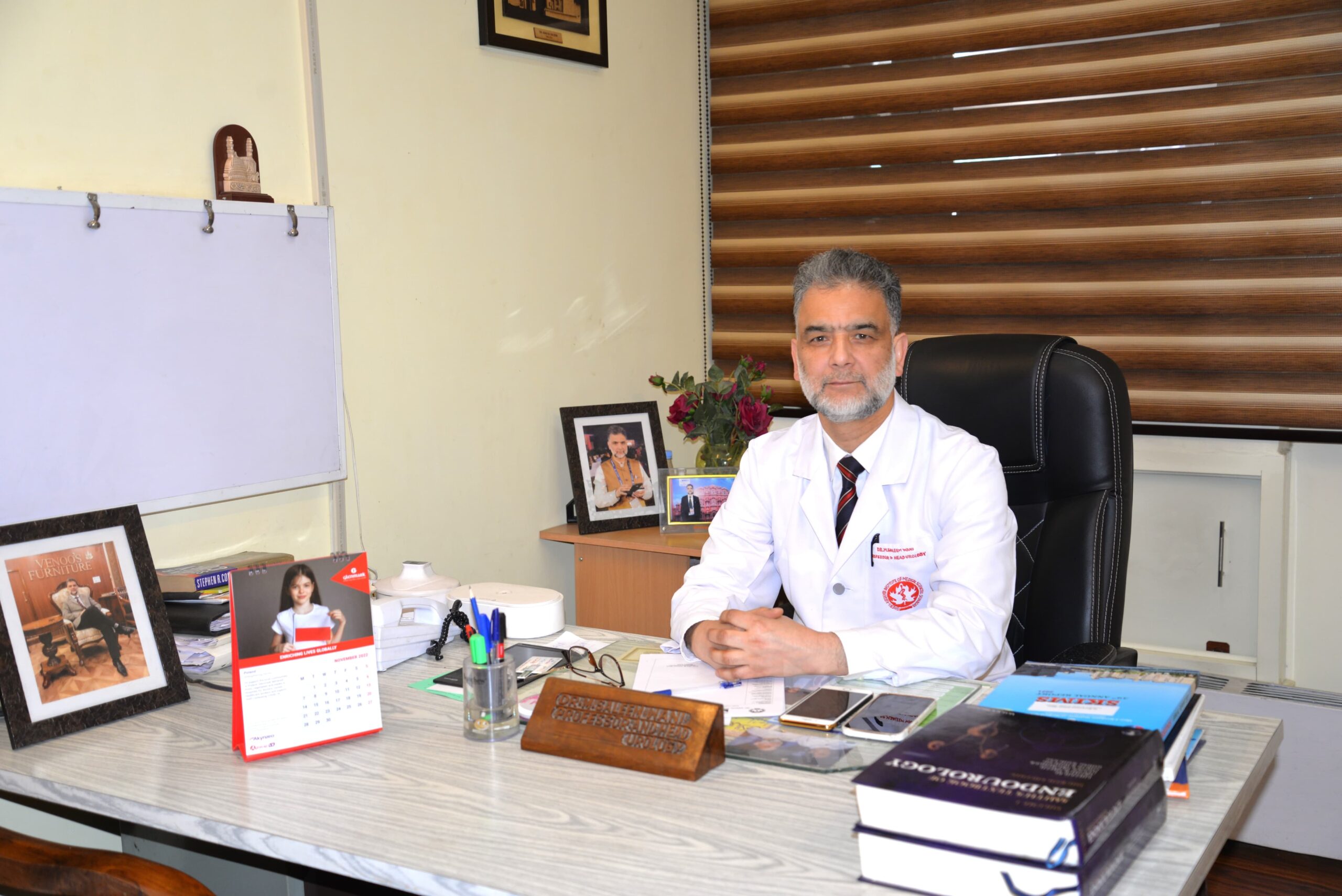By Tauheed Ahmad
Organ transplantation stands out as a remarkable achievement in medicine, providing a vital lifeline for individuals facing end-stage organ failure. Nevertheless, the effectiveness of this life-saving procedure relies heavily on the accessibility of organs. In the region of Jammu and Kashmir, the disparity between the number of patients eagerly awaiting transplants and the limited availability of organs is a cause for significant concern.
In an interview with Kashmir Scan Dr. Saleem Wani, a leading expert in Urology and Kidney Transplant Surgery at SKIMS sheds light on the transformative potential of cadaveric transplantation and its impact on the broader organ donation landscape.
Excerpts of the interview
KS: Can you provide our readers with a brief overview of the crisis and its impact on healthcare?
Dr. Saleem (DS): Certainly. The demand for organ transplants in India is staggering, with kidney transplantation serving as a poignant example. Annually, 1.8 lakh individuals require transplants, but only 5,000 kidney transplants are performed. This stark gap highlights the critical need for both living and cadaveric organ donations. Chronic kidney diseases, driven by factors like diabetes and hypertension, underscore the necessity of organ availability, positioning kidney transplantation as a vital and cost-effective strategy.
KS: The Human Organ Transplantation Act of 1994 plays a pivotal role in this landscape. Can you elaborate on its significance in permitting living-related and altruistic donations?
DS: Navigating the legal framework, the Human Organ Transplantation Act of 1994 is crucial. It permits living-related donations from close family members and altruistic donations, ensuring ethical practices and preventing the commercialization of organ transplantation. Adherence to this act is vital, and I advocate for heightened awareness and community participation in organ donation.
KS: Moving on to the Brainstem Death Certification Committee, can you shed light on how it ensures transparency and ethical standards in organ transplantation?
DS: Certainly. The Brainstem Death Certification Committee plays a vital role. We champion ongoing awareness programs among medical professionals and meticulously certify brainstem death, ensuring transparency and ethical practices in organ transplantation.

KS: Beyond kidney transplantation, what can you tell us about the demand-supply gap in organ transplants, especially with statistics for liver, heart, and cornea transplants?
DS: The gap is substantial. There’s a demand for 30,000 liver transplants annually, with only 1500 performed, and a need for 50,000 heart transplants, while only 15 see fruition. Cornea demands reach 10 lakh, yet only 35,000 are fulfilled.
KS: SKIMS has played a significant role in transplantation. Can you share more about SKIMS’s contributions and its significance in narrowing the organ demand-supply gap?
DS: Certainly. SKIMS has showcased a significant milestone of 550 kidney transplants. Positioned as a high-volume center, SKIMS Soura contributes 40 to 45 transplants annually, underscoring its pivotal role in narrowing the organ demand-supply gap.
KS: Can you explain how you leverage opportunities in the face of road accidents and brainstem death to salvage lives through organ transplantation, considering the ethical considerations involved?
DS: Seizing opportunities amid the tragedy of road accidents and brainstem death is a unique perspective. We harness organs from individuals facing brain death due to these accidents, emphasizing the chance to salvage lives. It’s a reminder that even in adversity, there exists an opportunity to bring hope and healing through organ transplantation.
KS: Looking at the global landscape, how have countries like Saudi Arabia, Iran, Iraq, Kuwait, Singapore, and Malaysia successfully integrated cadaveric transplantation into their healthcare systems?
DS: In these nations, despite diverse cultural and religious landscapes, cadaver transplantation has become a beacon of hope. They’ve successfully navigated challenges, seamlessly integrating cadaveric transplantation into their healthcare systems.
KS: Shifting our focus to the Certification Committee associated with NOTTO, how does it contribute to upholding the highest standards of integrity in organ transplantation?
DS: The Certification Committee associated with NOTTO is crucial. Comprising professionals in intensive care, neurosurgery, neurology, and grief counseling, it operates independently to uphold the highest standards of integrity, ensuring transparent and compassionate practices.
KS: Can you elaborate on the role of SOTTO in orchestrating collaboration among hospitals and the hierarchical approach to organ allocation?
DS: Certainly. SOTTO plays a pivotal role in orchestrating collaboration among hospitals. Maintaining comprehensive waiting lists, it adopts a hierarchical approach to organ allocation, ensuring optimal allocation based on recipient needs.
KS: The anonymity surrounding organ donation is a crucial aspect. Can you shed light on how it impacts the organ transplantation process?
DS: Anonymity is essential. It ensures the privacy of both donors and recipients. The secrecy, coupled with deep respect for donors’ families, adheres to established protocols and contributes to the transformative impact of organ transplantation.
KS: Looking at the challenges you’ve highlighted regarding the demand for liver, heart, and cornea transplants, how do you believe cadaver transplantation can alleviate these challenges?
DS: The staggering demand-supply gap underscores the critical need for cadaver transplantation. It has the potential to alleviate growing waiting lists and address the challenges faced in liver, heart, and cornea transplants.
KS: Emphasizing the role of green corridors and technical infrastructure, how do these aspects contribute to efficient organ retrieval and transportation?
DS: Green corridors are crucial for ensuring the safe and swift transportation of organs. Technical infrastructure is necessary for efficient organ retrieval, maintaining standardized and seamless procedures.
KS: What about the periodic evaluations conducted by NOTTO on certified organ transplant hospitals? How do these evaluations contribute to the continuous improvement of infrastructure?
DS: NOTTO’s periodic evaluations aim to gauge the status of certified organ transplant hospitals. This ongoing process ensures continuous improvement and adequacy of infrastructure in these facilities.
KS: How does NOTTO incentivize hospitals for creating or upgrading transplant and retrieval centers, and what role do awareness programs play in promoting cadaver transplantation?
DS: NOTTO incentivizes hospitals by providing funds for creating or upgrading transplant and retrieval centers. Awareness programs are crucial in promoting cadaver transplantation, with students becoming ambassadors to spread awareness.
KS: Recognizing the challenge in Jammu and Kashmir regarding organ donation awareness, what urgency do you see in not just promoting the campaign on organ donation but also in facilitating cadaveric transplantation processes?
DS: In Jammu and Kashmir, limited awareness poses a challenge with numerous lives at stake. The urgency lies not just in promoting organ donation but also in facilitating cadaveric transplantation processes to address the critical shortage.
KS: You’ve emphasized the pivotal role of public awareness. How can religious leaders play a role in dispelling transplantation myths and promoting organ donation?
DS: Multi-religious community support is vital for cadaver transplantation. Religious leaders can dispel myths and promote organ donation through comprehensive awareness programs targeting the broader community and the medical fraternity.
KS: How do you propose incorporating organ transplantation discussions into regular sermons to enhance awareness?
DS: Advocating for a strategy shift, I propose incorporating organ transplantation discussions into regular sermons, utilising the influence of religious leaders. Media channels can also play a role in dispelling myths and emphasising the significance of organ donation.

Leave a Reply